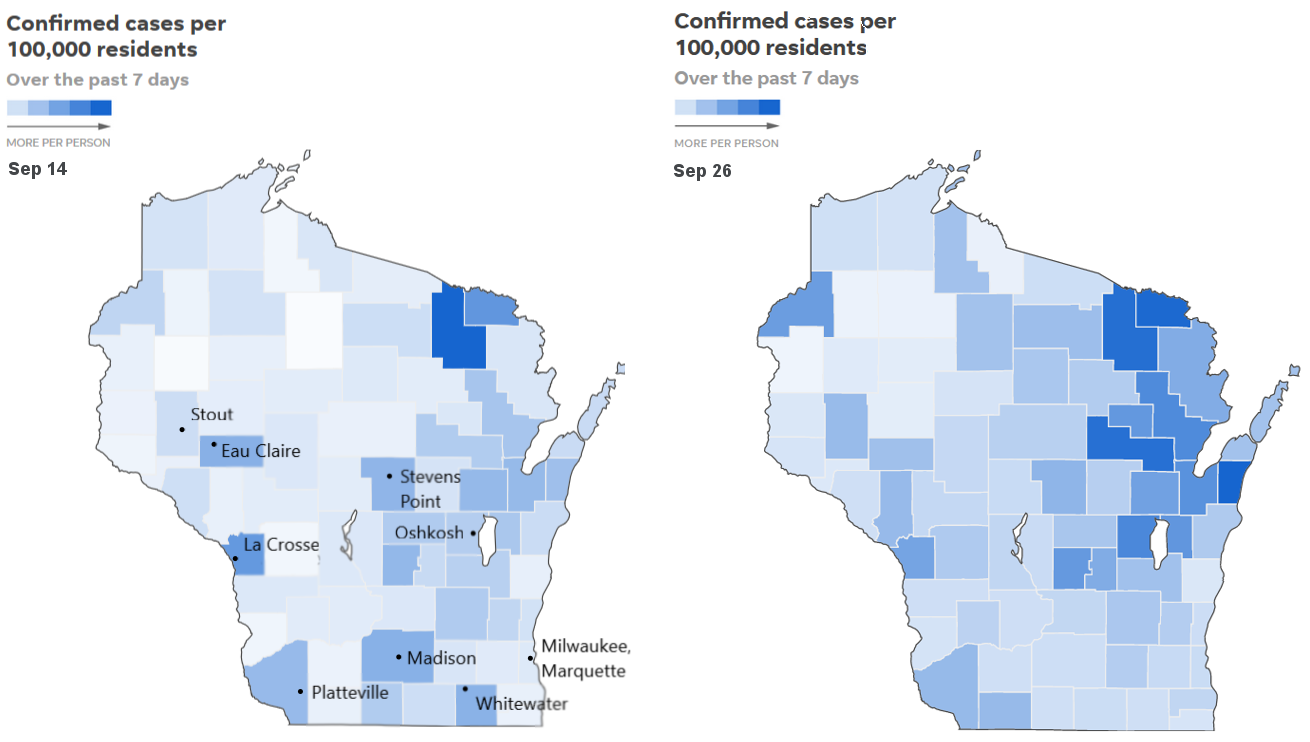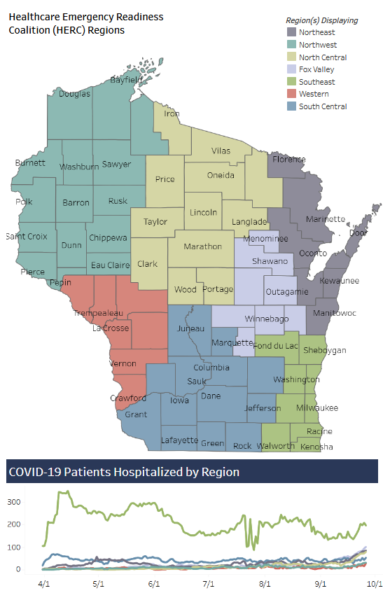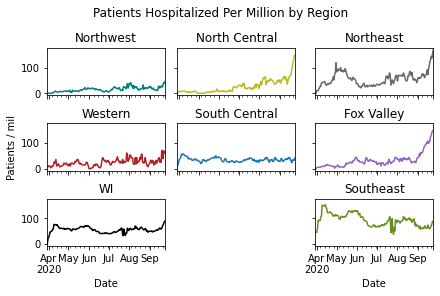Two outbreaks
26 Sep 2020Wisconsin has two outbreaks. The first is on college campuses. Cases exploded after classes began, especially at UW-Madison and UW-La Crosse, but at many other campuses as well. Dorms are quarantined, students are rushing to buy ramen before lockdown, and I get to tut-tut to myself about the party kids in Sellery and Witte.
But while this outbreak has possibly already peaked - at least at Madison, though not yet at Marquette and UW-Milwaukee - a second outbreak is underway in the northeast corner of the state. I believe this second outbreak is more serious, although I think it has received less media coverage. It comes with a rapid increase in hospitalizations due to (I’m guessing) less of a skew towards young people. Wisconsin is at a record high for current people hospitalized - 574 at this writing - and this outbreak is what is driving that trend.
As you look at the case map of the state, over time, the succession of these two outbreaks stands out. Below are screenshots of the Journal Sentinel’s map tracker, taken on September 14 and September 26. They show 7-day case counts, per population, by county. Two weeks ago counties with large colleges stood out strongly. Today, in late September, they stand out much less and Green Bay and the Fox Valley are clearly the epicenter.

The situation is worse when looking at hospitalizations. The Wisconsin DHS has a hospital dashboard by region, which shows the number of currently hospitalized patients in 7 regions of the state. A screenshot of this dashboard is below.

The Southeast region around Milwaukee is more populous, however, so it dominates the plot too much. So I broke out the data for individual regions, and scaled it per population. Covid patients in the Northeast (Green Bay), Fox Valley, and North Central regions are spiking, in correlation with these regions’ fast-growing case trajectories.

Comparing with the South Central region, centered on Madison, raises an important distinction. UW-Madison’s student outbreak has not led to large growth in hospitalizations, at least not yet. North and Northeast WI, we can see, is a different story.
Finally, we can compare college counties and northeast counties directly. I picked seven counties with relatively large schools, and where I think the school is likely driving the Covid numbers: Dane (Madison), La Crosse, Eau Claire, Walworth (Whitewater), Grant (Platteville), Dunn (Stout), and Portage (Stevens Point). I did not include Milwaukee or Brown (Green Bay), because I think their dynamics are different at the moment. I then compared this collection of counties to the combined Northeast and Fox Valley regions in the DHS’s hospital map.
These two aggregates have have very similar total populations, about 103,000 for both. In the plots below, which show average daily new cases and average daily new hospitalizations, respectively, the two collections of counties are labeled “Colleges” in Wisconsin red and white, and “Packerland” in green.

For cases, the college counties shot up fast about three weeks ago, but have actually turned a corner recently and started coming back down. In Packerland, unfortunately, cases are still going up. The college counties also show a significant bump in July, when 20-somethings drove an earlier wave, that is not visible for the northeast.
The hospitalizations trend is even more consequential. The college counties show some increase but not a strong one, at least not yet. I take that as a hopeful sign that those outbreaks were somewhat successfully contained to the college students. The northeast counties, on the other hand, have just about tripled their daily hospitalizations over the last month. It seems likely that the outbreak there must be more widely spread among age groups to result in these hospitalizations, and that it is the result of more general community spread rather than being only driven by colleges.
The college counties just might have gotten their outbreaks under control. We will see if that holds. The northeast is now more serious, and I hope it gets more attention.
UPDATE: Two days after this post, the Milwaukee Journal sentinel published a story with very similar conclusions, including evidence that hospital capacity in the northeast is starting to fill.
